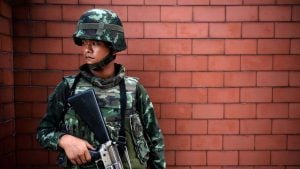Philippines plans to procure Brahmos land-based supersonic anti-ship missile system from India
- The development of BrahMos is based on the Russian made P-800 Oniks / Yakhont supersonic anti-ship cruise missile. The BrahMos propulsion is based on the Oniks, while the guidance system was developed by BrahMos Aerospace. The first flight test involving BrahMos anti-ship missile was carried out on June 12, 2001, in the Interim Test Range in the state of Orissa, India.
- The ship-based BrahMos missiles can carry a conventional semi-armour-piercing warhead of 200 kg. According to India, the Brahmos missile is claimed to be the fastest low-altitude missile in the world. It has a maximum firing range of 500 km.
- The Brahmos missile is powered by a two-stage power-plant, with a solid-fuel rocket providing the first stage, accelerating the missile to supersonic speeds and with a liquid-fuelled ramjet as the second stage, accelerating it to a maximum speed of Mach 2.8.
- Block III has advanced guidance and upgraded software, incorporating high manoeuvres at multiple points and steep dive from high altitude. The steep dive capability of the Block III enables it to hit targets hidden behind a mountain range. It can engage ground targets from an altitude as low as 10 meters for precision strikes without any collateral damage. It is capable of being launched from multiple platforms like submarines, ships, aircraft, and land-based Mobile Autonomous Launchers (MAL).
British Army launched its first cyberwar regiment
- Britain’s first dedicated cyber regiment has been officially established as part of the Army’s drive to modernize its response to the growing digital threat posed by potential adversaries.
- Creation of the unit, the 13th Signals Regiment, is part of an ongoing restructuring of the British Army, known as Army 2020 Refine, which includes the creation of a division conducting cyber, electronic warfare, intelligence, information operations and unconventional warfare.
- The cyber regiment is built around a core of about 250 specialists and is tasked with combating threats to Army operations overseas and domestically. The new unit will also provide technical support for a hub being set up to test and implement next-generation information capabilities.
- Announcing the formation of the new unit, Defense Secretary Ben Wallace said the move was “a step-change in the modernization of the UK armed forces for information warfare. Cyber-attacks are every bit as deadly as those faced on the physical battlefield, so we must prepare to defend ourselves from all those who would do us harm, and 13th Signal Regiment is a vital addition to that defense.”
- The new unit is based at Blanford, southwest England, the home of Britain’s Royal Signals.
New Zealand military buys 5 Lockheed Hercules planes for $1 billion
- New Zealand’s military said Friday it will buy five Super Hercules transport planes from Lockheed Martin for $1 billion.
- The planes will replace the military’s existing fleet of Hercules, all of which are more than 50 years old and have been involved in a series of embarrassing breakdowns over recent years.
- Defence Minister Ron Mark said the new planes will be used for operations in New Zealand, the South Pacific and Antarctica.
- Three of the nation’s current C-130 Hercules planes date back to 1965 and the other two to 1969. They have been upgraded over the years, but frequent breakdowns have hampered some high-profile missions. At one-point last year, the entire fleet was temporarily grounded.
- New Zealand will take delivery of the first of the new C-130J-30 aircraft in 2024 with the full fleet operating by 2025. The price tag of 1.5 billion New Zealand dollars (nearly U.S. $1 billion) includes a flight simulator and supporting infrastructure.
Jammu & Kashmir News
- Five Hizbul Mujahideen terrorists, including a top commander of the outfit, were on Sunday killed in an encounter with security forces in Shopian district of Jammu and Kashmir.
- On a specific input, the security forces launched a cordon and search operation in Reban area of south Kashmir district, a police spokesperson said. During the search operation, the hiding terrorists opened fire at the search party of the forces, which was retaliated leading to an encounter.
- In the ensuing encounter, five Hizbul Mujahideen terrorists were killed and their bodies were retrieved from the site of the encounter.
- As per credible sources, the killed terrorists belonged to the proscribed Hizbul Mujahideen terror outfit and one among them is believed to be a top commander.
Ladakh stand-off: Talks between senior army officers of India and China end with ‘positive trajectory’
- India and China held their first round of talks between senior military officers on Saturday at the Chushul-Moldo point along the Line of Actual Control in Ladakh with sources expressing “satisfaction at the positive trajectory” in the bid to resolve the month-long troop confrontation in the Himalayan region.
- There was no official word on the outcome of the marathon meeting between the Indian delegation led by 14 Corps commander Lt-General Harinder Singh and the Chinese side headed by South Xinjiang Military District commander Major General Liu Lin.
- But sources said the meeting was “positive” and could eventually lead to restoration of status quo ante in eastern Ladakh, with both sides de-inducting soldiers and heavy weaponry from the confrontation sites at the northern bank of Pangong Tso (Tso means lake), Gogra-Hot Springs area and Galwan Valley region in a phased manner. The points lie along the LAC with Chinese troops having intruded into the Indian side at places leading to counter-mobilisation.
- The Indian delegation crossed over into Chinese territory for the meeting, at the Chushul-Moldo border personnel meeting (BPM) point in eastern Ladakh, at about 11am. The dialogue, interspersed by lunch, carried on till the evening. The accommodative note in Indian and Chinese statements on Friday had indicated the talks would not be a failure though more heavy lifting could be needed.
- “It may require some more military as well as diplomatic meetings for the actual de-escalation to take place,” said a source. The meeting on Saturday came a day after joint secretary-level diplomatic talks between India and China reiterated that the two countries should not allow their differences to turn into disputes, in tune with the strategic guidance given by PM Narendra Modi and President Xi Jinping.
- The earlier almost dozen meetings between the opposing commanders, including three at the Major-General level, had failed to break the deadlock with both the armies sticking to their respective positions.
- The People’s Liberation Army is strongly opposed to India’s construction of feeder roads and bridges in what it calls “disputed areas” like Pangong Tso and the Galwan Valley region. The Indian side is equally determined that Chinese vacate the intrusions and is also committed to developing the border infrastructure.
- The Indian side has stressed that its infrastructure build-up was “well within Indian territory”. The Indian Army has asked the PLA to restore status quo ante by withdrawing its troops, who have dug in and built fortifications after physically occupying the “Finger-4 to Finger 8” (mountainous spurs) area on the northern bank of Pangong Tso as well as the Galwan Valley region and Gogra-Hot Springs area.
- The PLA, in particular, is upset over India’s attempt to construct a feeder road joining “Patrolling Point-14” in the Galwan Valley to the 255-km Darbuk-Shyok-Daulat Beg Oldie (DBO) as well as a bridge in the region. The infrastructure upgrade will provide Indian troops with swifter and easier access to areas like the strategically important Karakoram Pass, Depsang plains and Galwan Valley, among other areas, to challenge the PLA’s relatively uncontested dominance in the region till now.
- The mobilisation of PLA troops in mid-April and then the multiple intrusions into Indian territory in eastern Ladakh in early-May in a well-coordinated manner across a broad frontage on the LAC initially caught the Indian Army off-guard.
- India, of course, has now more than matched the PLA build-up by moving forward troops of the Leh-based 3 Infantry Division into their “operational alert areas” as well as pumping in several additional battalions into Ladakh from other regions. “We are prepared for the long haul if it comes to that. We have enough acclimatised troops along the LAC in eastern Ladakh now,” said another source.
Operation Dolphin Nose: NIA arrests 53-year-old businessman for leaking vital Navy information
- The National Investigation Agency (NIA) on Friday arrested a 53-year-old Abdul Rehman Abdul Jabbar Sheikh, a Mumbai resident, who is believed to be a conspirator in the Visakhapatnam espionage case. Sheikh’s wife Shaista Qaiser, who was born in Pakistan, was earlier arrested in connection with the same case for terror funding as part of the operation code-named ‘Dolphin Nose’.
- Sheikh, a resident of Agripada in south Mumbai, is a businessman and runs a firm named ‘SR Enterprises’ which exports groundnut to Afghanistan. Sheikh used his wife’s phone to share crucial information regarding positioning of Indian Navy ships and submarines at its critical bases. NIA conducted a search at Sheikh’s residence on Saturday and seized digital devices and incriminating documents from his house.
- Earlier, apart Qaiser, NIA had arrested key conspirator Mohammed Haroon Haji Abdul Rehman Lakdawala from south Mumbai on May 15. During searches at Lakdawala’s house, several digital devices and incriminating documents had also been seized by NIA.
- Sheikh is the fifteenth arrest made in operation ‘Dolphin Nose’ wherein the espionage racket was busted by the Special Intelligence Branch of the Andhra Pradesh Police along with Naval Intelligence and the Intelligence Bureau. The case was later transferred to NIA.
- “Lakdawala had travelled to Karachi under the guise of conducting cross-border trade and used to meet Pakistani spies, possible code-named Akbar alias Ali and Rizwan,” said an NIA official.
- The first arrests were made on December 20 when the agencies arrested seven Indian Navy personnel from Visakhapatnam, Mumbai and Karwar bases along with one hawala operator. Later in February, three more navy personnel were arrested in the case along with Pakistan-born Indian national Shaista Qaiser.
- Pakistan’s Inter-Services Intelligence (ISI) agents had honey-trapped the Indian sailors through Facebook, WhatsApp, and online dating sites, and were allegedly paid through Indian conduits for getting crucial information regarding positioning of Indian Navy ships and submarines at its critical bases, said sources in the intelligence agencies. After the sailors fell for the ‘women’ on the dating sites, which were profiles created by ISI, the ‘women’ would introduce them to a businessman, a Pakistani handler, who elicited information the sailors, said NIA officials. If the sailor refused to reveal certain information, the ‘women’ would then blackmail them by threatening to reveal their online chats which were sexual in nature, and extract information about positions and movements of our vessels, added NIA officials.
- The espionage racket started in 2018, and the sailors were paid through a hawala operator who has been arrested. Lakdawala was directly involved in depositing money into the bank accounts of the Navy personnel at regular intervals through different methods,” said an official, requesting anonymity.
Operation Samudra Setu – INS Jalashwa Arrives at Tuticorin with 700 Indian Citizens Embarked from Maldives
- INS Jalashwa, deployed by the Indian Navy for “Operation Samudra Setu”, entered Tuticorin harbour with 700 Indian nationals evacuated from Male, Maldives on 07 June 2020. Thus far INS Jalashwa has evacuated 2672 Indian citizens from Maldives and Sri Lanka to India as part of Vande Bharat Mission.
- The embarkation of Indian nationals was facilitated by the Indian Mission in Maldives. Personnel were embarked onboard after carrying out requisite medical screening. COVID related safety protocols were also strictly adhered to during the sea-passage.
- The evacuees were received by local authorities at Tuticorin and arrangements were in place for speedy disembarkation, health screening, immigration, and transportation of the evacuees.
- With this evacuation, the Indian Navy has now repatriated 2874 Indian nationals from the Maldives and Sri Lanka during the ongoing pandemic.
Mission Sagar – INS Kesari at Port Victoria, Seychelles
- As part of Mission Sagar, Indian Naval Ship Kesari entered Port Victoria, Seychelles, on 07 June 2020. The Government of India in these difficult times is aiding Friendly Foreign Countries in dealing with the COVID-19 pandemic and towards the same INS Kesari is carrying a consignment of COVID related essential medicines for the people of Seychelles.
- An official ceremony for handing over the medicines from the Government of India to Government of Seychelles was held on 07 June 2020. Secretary of state for Foreign Affairs, H.E Ambassador Barry Faure and Secretary of State for Health, H.E Ambassador Marie Pierre Lloyd, represented the Government of Seychelles at the ceremony. The Indian side was represented by the High Commissioner of India to Seychelles, H.E General Dalbir Singh Suhag PVSM, UYSM, AVSM, VSM (Retd) and the Second Secretary to HCI, Mr Ashwin Bhaskaran.
- The assistance to Seychelles is a part of the Government of India outreach amidst the ongoing COVID-19 pandemic. ‘Mission Sagar’ builds on the excellent relations existing between the two countries to battle the COVID-19 pandemic and its resultant difficulties. The deployment also resonates the vision of our Prime Minister of Security and Growth for All in the Region ‘SAGAR’ and highlights the importance accorded by India to relations with the countries in the IOR. The operation is being progressed in close coordination with the Ministry of External Affairs, and other agencies of the Government of India.
This day in World History – Normandy Landings
- The Normandy landings were the landing operations and associated airborne operations on Tuesday, 6 June 1944 of the Allied invasion of Normandy in Operation Overlord during World War II. Codenamed Operation Neptune and often referred to as D-Day, it was the largest seaborne invasion in history. The operation began the liberation of German-occupied France (and later western Europe) and laid the foundations of the Allied victory on the Western Front.
- Planning for the operation began in 1943. In the months leading up to the invasion, the Allies conducted a substantial military deception, codenamed Operation Bodyguard, to mislead the Germans as to the date and location of the main Allied landings. The weather on D-Day was far from ideal, and the operation had to be delayed 24 hours; a further postponement would have meant a delay of at least two weeks, as the invasion planners had requirements for the phase of the moon, the tides, and the time of day that meant only a few days each month were deemed suitable. Adolf Hitler placed Field Marshal Erwin Rommel in command of German forces and of developing fortifications along the Atlantic Wall in anticipation of an Allied invasion.
- The amphibious landings were preceded by extensive aerial and naval bombardment and an airborne assault—the landing of 24,000 American, British, and Canadian airborne troops shortly after midnight. Allied infantry and armoured divisions began landing on the coast of France at 06:30. The target 50-mile (80 km) stretch of the Normandy coast was divided into five sectors: Utah, Omaha, Gold, Juno, and Sword. Strong winds blew the landing craft east of their intended positions, particularly at Utah and Omaha. The men landed under heavy fire from gun emplacements overlooking the beaches, and the shore was mined and covered with obstacles such as wooden stakes, metal tripods, and barbed wire, making the work of the beach-clearing teams difficult and dangerous. Casualties were heaviest at Omaha, with its high cliffs. At Gold, Juno, and Sword, several fortified towns were cleared in house-to-house fighting, and two major gun emplacements at Gold were disabled using specialised tanks.
- The Allies failed to achieve any of their goals on the first day. Carentan, St. Lô, and Bayeux remained in German hands, and Caen, a major objective, was not captured until 21 July. Only two of the beaches (Juno and Gold) were linked on the first day, and all five beachheads were not connected until 12 June; however, the operation gained a foothold that the Allies gradually expanded over the coming months. German casualties on D-Day have been estimated at 4,000 to 9,000 men. Allied casualties were documented for at least 10,000, with 4,414 confirmed dead. Museums, memorials, and war cemeteries in the area now host many visitors each year.
REVIEW QUESTIONS
- India and China held their first round of talks between senior military officers on Saturday at which point along the Line of Actual Control in Ladakh?
- Nathu La
- Bum La
- Daulat Beg Oldi
- Chushul-Moldo
ANSWER: D
- Which Indian Army official participated in the official ceremony for handing over the medicines from the Government of India to Government of Seychelles on 07 June 2020?
- General Dalbir Singh Suhag, PVSM, UYSM, AVSM, VSM (Retd)
- General Bipin Rawat, PVSM, UYSM, AVSM, YSM, SM, VSM, ADC
- General Bikram Singh, PVSM, UYSM, AVSM, SM, VSM, ADC (Retd)
- General S. Padmanabhan, PVSM, AVSM, VSM (Retd)
ANSWER: A
- Maximum speed of BrahMos Cruise Missile:
- Mach 2
- Mach 3
- Mach 4
- Mach 5
ANSWER: B
- Normandy landings were associated with which operation of US Armed Forces?
- Operation Rolling Thunder
- Operation Red Dawn
- Operation Overload
- Operation Urgent Fury
ANSWER: C
- Generally, Operation Dolphin Nose, that was aimed to crack the Visakhapatnam Espionage Racket, is named so because:
- The Espionage Racket involved Dolphins unauthorized trade
- Dolphin’s Nose is a beach in Visakhapatnam with less human populace
- Dolphin’s Nose is a movie associated with this operation
- Dolphin’s Nose is a hill in Visakhapatnam between Yarada and Gangavaram Port
ANSWER: D



















